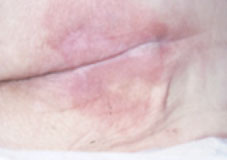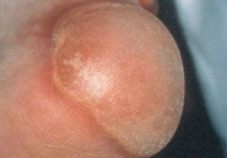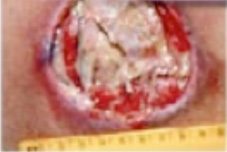What stage is the pressure area?
 This is a stage 1 pressure area. There is a defined area of redness compared to the surrounding area of the body. The person may report that it is itchy or painful. The skin is not broken. Image courtesy S. Dean - Woundscope.
This is a stage 1 pressure area. There is a defined area of redness compared to the surrounding area of the body. The person may report that it is itchy or painful. The skin is not broken. Image courtesy S. Dean - Woundscope.
 This is a stage 2 pressure area, for which the symptoms include partial thickness skin loss. The area is shallow and may look like a graze, blister or shallow crater. Image courtesy S. Abbots.
This is a stage 2 pressure area, for which the symptoms include partial thickness skin loss. The area is shallow and may look like a graze, blister or shallow crater. Image courtesy S. Abbots.
 This is a stage 3 pressure area. There is full thickness skin loss involving damage to, or death of, tissue structures that may extend down to but not through the underlying fascia. May look like a deep crater. Image courtesy R. Martin.
This is a stage 3 pressure area. There is full thickness skin loss involving damage to, or death of, tissue structures that may extend down to but not through the underlying fascia. May look like a deep crater. Image courtesy R. Martin.
 This is a stage 4 pressure area. There is full thickness skin loss with extensive destruction, tissue death, or damage to underlying muscle, bone or supporting structures. Undermining and sinus tracts may also be present. This may extend further than you can see under the surface. Image courtesy L. Murray.
This is a stage 4 pressure area. There is full thickness skin loss with extensive destruction, tissue death, or damage to underlying muscle, bone or supporting structures. Undermining and sinus tracts may also be present. This may extend further than you can see under the surface. Image courtesy L. Murray.If a pressure area is found, it is important that it is graded or staged to determine the degree of observable tissue damage. It is important that you report any pressure area to your supervisor immediately.
Click on the Next button to continue.